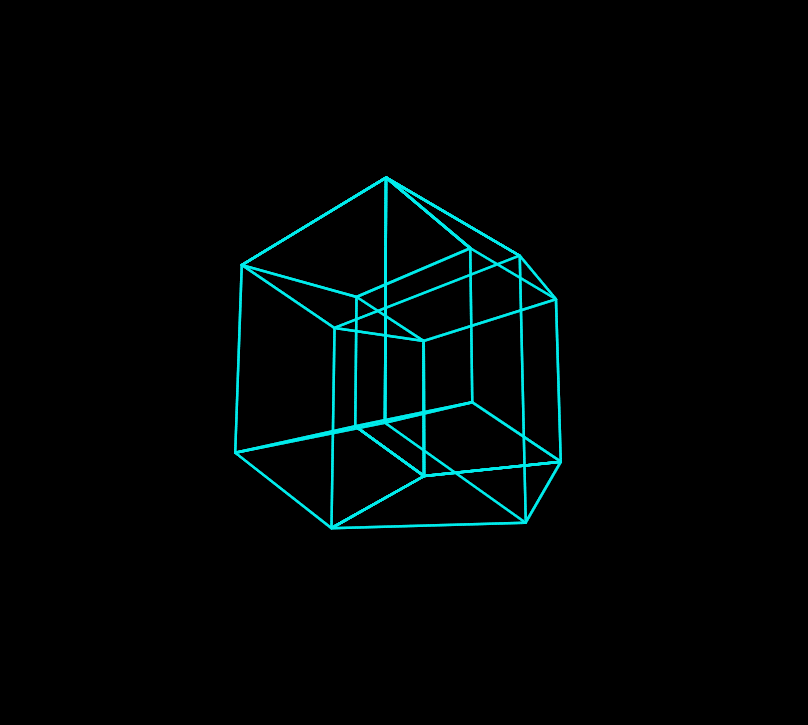Your cart is currently empty!

Mastering the Tesseract
Understanding the Tesseract as a tool for the Perception of Reality
The animation of a tesseract is often used to illustrate a four-dimensional object—a concept difficult for our three-dimensional minds to grasp. While this animation might seem like a purely mathematical or geometric tool, it can actually provide a fascinating framework for understanding how we perceive the reality around us. By looking at the tesseract, time can be conceptualized as an axis, much like the familiar x, y, or z axes that define space in three dimensions.
Time and Space
In modern physics, time is often described as a physical dimension, much like the three spatial dimensions we interact with. Together, time and space form a continuum known as spacetime. In Einstein’s theory of relativity, time is inextricably linked to space; changes in space affect the passage of time and vice versa. This concept of spacetime is fundamental to our understanding of the universe, where events are not only located in space but also in time.
Neuroscientific research supports this idea by showing how the brain processes time and space through overlapping yet distinct neural networks. Studies on time cells and place cells in the brain reveal that both time and space are represented as cognitive maps that allow us to navigate and understand our surroundings. Further research highlights that the brain uses these distinct yet interconnected systems to help us interact with both time and space in meaningful ways.
Research into temporal cognition reveals that our perception of time is not tied to a specific sensory system but is distributed across various brain functions. As the brain processes movement and spatial relationships, time is inherently woven into our experience of these changes. This supports the idea that time is experienced through motion, much like the movements we perceive in a tesseract animation.
In the case of the tesseract, the movement between keyframes represents this passage of time—a dimension we primarily perceive through change and motion. The rotation along an axis we cannot perceive must be projected onto dimensions we can perceive, much like how time is often inferred from changes in our environment. This concept parallels some of the ideas found in Projection Theory from physics, which suggests our three-dimensional reality is a projection of a higher-dimensional space, with time acting as the key medium for translating information from higher dimensions into our experience.
Time and Space Are Intertwined
The static nature of the tesseract itself contrasts with the motion we observe when attempting to communicate higher-dimensional concepts. The perceived movement stems from the information being presented through projections in lower dimensions—essentially, we are attempting to simulate a four-dimensional object using three-dimensional perspectives. This interplay between time and space forms the foundation of spacetime, where both dimensions are deeply connected. Neuroscientific studies have shown that brain regions responsible for spatial awareness also play a role in processing time, further supporting the concept of time as a physical dimension.
Perception as a Product of Projection
Our understanding of reality is not purely objective. In fact, cognitive psychology tells us that the vast majority of what we perceive is shaped by internal beliefs and prior experiences. “What we perceive is determined not so much by the external world, but by what we project onto it.” Our brains process sensory data through filters of memory, emotion, and cognition, meaning much of what we see is influenced by what we expect to see. This process is known as psychological projection.
Research such as the Projection Experiment delves deeper into how cognitive processes actively shape what we perceive. The experiment found that our interpretations of reality are heavily influenced by mental projections, further reinforcing that much of what we consider reality is filtered through our psychological projections. Additionally, memory plays a significant role in this process. Studies on memory and perception show that memory influences perception significantly, altering the way we see objects and environments based on what we already know. This demonstrates that even our memories affect how we experience the present, blurring the line between objective reality and subjective interpretation.
This applies not only to individual perception but also to collective human behavior. Projection theory suggests that just as individuals filter their perceptions through their psychological states, societies can project collective beliefs, fears, and biases onto reality. When large groups of people share similar psychological projections, these can shape cultural narratives, ideologies, and even political systems. Societal systems, much like individual behavior, are shaped by shared perceptions and projections, forming the foundation of collective ideologies and actions. The collective projections of a society can reinforce certain perceptions of reality, sometimes blurring the line between fact and interpretation. This insight invites us to reflect on how collective consciousness operates, and how much of our shared worldview may be a projection of collective hopes, fears, and prior experiences.
The Tesseract as a Model for Human Experience
In a broader sense, the tesseract can also be used as a metaphor for how human beings experience life. We can imagine living in a tesseract, where our lives consist of three-dimensional projections shaped by the vast array of internal and external influences. Much of what we think of as reality is a mental construct, built on layers of memories, perceptions, and projections. As cognitive science continues to show, we are constantly filtering the world through our own minds, making it difficult to separate the objective from the subjective.
On a larger scale, this metaphor can be extended to the human species as a whole. One could argue that humanity is a single entity experiencing itself through the third dimension, while the individual experiences we each subscribe to are simply byproducts of this larger existence. This perspective invites a deeper philosophical consideration of how our collective consciousness might operate, with individual experiences serving as threads in the larger fabric of shared human experience.
Read More:
Time and Space
- Time and Space in the Brain
- Mapping Time and Space: Neurons Decode Human Existence Dimensions
- Temporal Cognition and the Brain
- Projection Theory in Physics
Perception and Psychological Projection
- Perception and Projection
- Memory and Perception: The Influence of Projections
- Projection Experiment
- The Influence of Memory on Perception: It’s Not What Things Look Like, It’s What You Call Them
- How Memories of Events in Your Past May Affect Perception

Leave a Reply